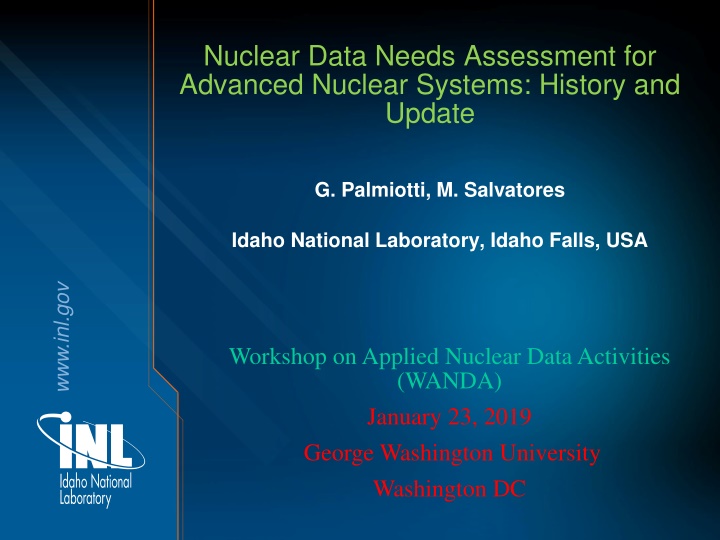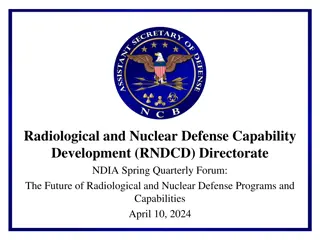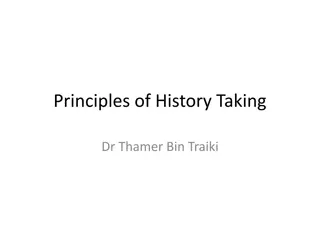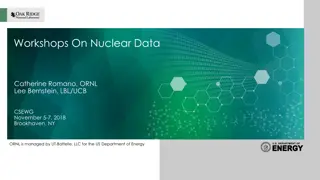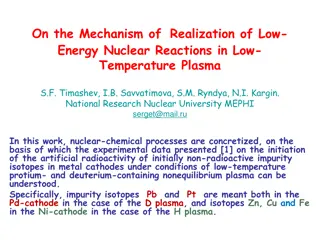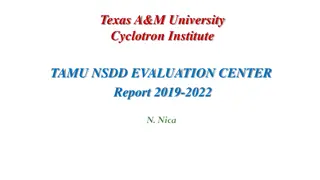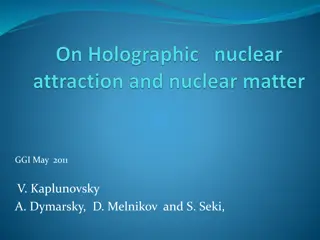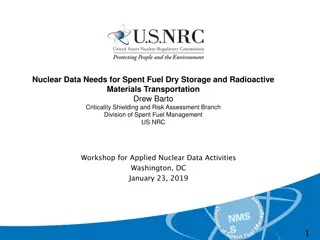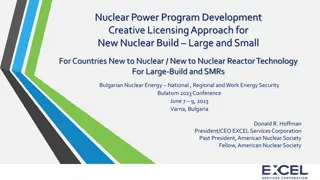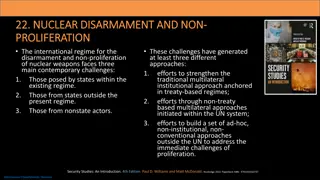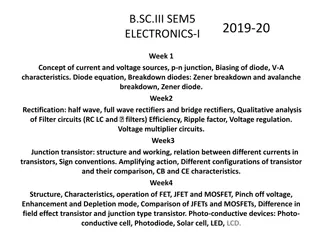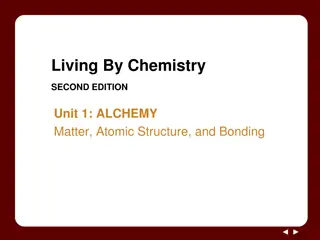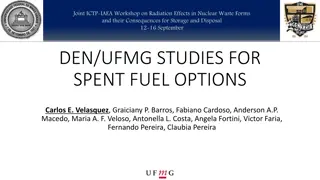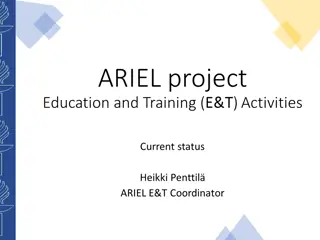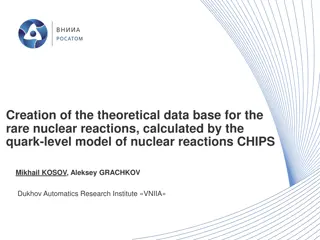Nuclear Data Needs Assessment for Advanced Nuclear Systems: History and Update
This article provides an overview of nuclear data needs assessment for advanced nuclear systems, focusing on target accuracies, data uncertainties, and High Priority Request List (HPRL) development. It discusses the driving forces behind data assessment, expert participation in the process, and analyses of integral parameters for various reactor systems like ABTR, SFR, EFR, GFR, LFR, ADMAB, VHTR, and Extended BU PWR.
Download Presentation

Please find below an Image/Link to download the presentation.
The content on the website is provided AS IS for your information and personal use only. It may not be sold, licensed, or shared on other websites without obtaining consent from the author.If you encounter any issues during the download, it is possible that the publisher has removed the file from their server.
You are allowed to download the files provided on this website for personal or commercial use, subject to the condition that they are used lawfully. All files are the property of their respective owners.
The content on the website is provided AS IS for your information and personal use only. It may not be sold, licensed, or shared on other websites without obtaining consent from the author.
E N D
Presentation Transcript
Nuclear Data Needs Assessment for Advanced Nuclear Systems: History and Update G. Palmiotti, M. Salvatores Idaho National Laboratory, Idaho Falls, USA www.inl.gov Workshop on Applied Nuclear Data Activities (WANDA) January 23, 2019 George Washington University Washington DC
Data uncertainties, target accuracies and HPRL (High Priority Request List): Starting point (~2005) Three main driving forces: Data needs assessment: at the time of fashionable ADS, there was a multiplication of data requirements more or less justified; A powerful initiative, GENERATION-IV, did trigger a much wider effort; This has been the case also for new nuclear fuel cycles and waste management issues. In order to rationalize and streamline potential needs and high priority requests, target accuracies were defined. Both uncertainties /covariance preliminary data (BOLNA) and sensitivity tools were available for some SUA (Sensitivity and Uncertainty Analysis). Users (in some cases including industry) were consulted.
NEA WPEC SG26; 2005-2008: Large expert participation; provocative uncertainty data (expert judgement) were initially used (BOLNA). Did trigger wide effort to assess systematically uncertainty data e.g. JENDL at JAEA, COMMARA at BNL/LANL/ORNL and COMAC at CEA. A first list of data priorities (i.e. for uncertainty reduction) for GEN-IV reactors was established and implemented in the HPRL at NEA
Systems and Integral Parameters Analyzed As indicated in the introduction, eight systems, related to Gen-IV, AFCI and GNEP, have been considered. Geometry and compositions are presented in Appendix A and their main features are: 1.ABTR: 250 MWth Na cooled; U-TRU-10Zr fuel; HT9(75%)-Na(15%) reflector; enrichment: 17%, MA: <1%; irradiation cycle: 109.8 days (4 months at 90% capacity); 2.SFR: (Burner: CR=0.25) 840 MWth Na cooled; U-TRU-Zr metallic alloy fuel; SS reflector; enrichment: 56%, MA: 10%; irradiation cycle: 155 days; 3.EFR: 3600 MWth Na cooled; U-TRU oxide fuel; U blanket; enrichment: 22%, MA: 1%; irradiation cycle: 1700 days; 4.GFR: 2400 MWth He cooled; SiC - (U-TRU)C fuel; Zr3Si2 reflector; enrichment: 17%, MA: 5%; irradiation cycle: 415 days; 5.LFR: 900 MWth Pb cooled; U-TRU-Zr metallic alloy fuel; Pb reflector; enrichment: 21%, MA: 2%; irradiation cycle: 310 days; 6.ADMAB: 377 MWth Pb-Bi cooled; TRU fuel; HT9(70%) Pb-Bi(30%) reflector; enrichment: 32%, MA: 67%; irradiation cycle: 366 days; 7.VHTR: TRISO fuel; enrichment: 14%; burnup: 90 GW d/Kg; 8.Extended BU PWR: enrichment: 8.5%; burnup: 100 GW d/Kg.
Target Accuracy on Integral Parameters From SG26: Multiplication factor (BOL) Power peak (BOL) Burnup reactivity swing Reactivity coefficients (Coolant void and Doppler - BOL) Major nuclide density at end of irradiation cycle Other nuclide density at end of irradiation cycle 300 pcm 2% 300 pcm 7% 2% 10% Fast Reactors Criticality Local power (in fuel compact) Burnup (cycle length) Doppler coefficient Moderator temperature coefficient Nuclide inventories at EOL Main fissile isotopes Fertile isotopes MAs and FPs 300 pcm (operation); 500 pcm (safety) 6% (2% in pin-wise fission rate of fresh fuel; 4% in main fissile isotope conc. of irradiated fuel) 1% ( ~ 500 MWd/t) 20% 1 pcm/ C 4% 5% 20% HTR Doppler Burnup 500 pcm keff Transmutation Reactivity Coefficient 10% 0.5% 5% PWR
What is new from the time of the SG26 study: New reactors concepts are presently explored besides Gen IV, MA burners, and ADS: MSR, SMR, micro reactors, and test reactors Data and accuracies are required for new materials, reaction types and energy ranges It is essential to verify the status of design target accuracies and their potential evolution (reactor and fuel cycle) The HPRL will certainly benefit from an update, to motivate and focus new experiments and to meet potential new requirements
New covariance data matrices are now available: the very preliminary, expert judgement-based BOLNA was used, while today ENDF, JEFF, and JENDL and potentially other data files have more reliable covariance data. At the time of SG26 correlations were neglected: a partial investigation that showed a significant impact on the results. These correlations (in energy, in some cases among different cross sections of same isotope or different isotopes) are available even still under development included correlations
Target Accuracy Requirements Exercise A new NEA WPEC Subgroup, the SG46 devoted to Efficient and Effective Use of Integral Experiments for Nuclear Data Validation , has explicitly in its mandate an action for updating target accuracy requirements. From the mandate, The SG46 should provide guidelines on: How to systematically quantify uncertainty impact on a list of selected target power reactors (thermal, epithermal, and fast spectrum). This list should be defined as far as possible with the help of industry reprentatives. How to provide updated target accuracies for nuclear data uncertainty reduction . Following this a target accuracy requirement exercise has been proposed within the SG46 activities in order to produce new and updated entries for the HPRL.
Target accuracy requirements via sensitivity analysis To establish priorities and target accuracies on data uncertainty reduction, a formal approach can be adopted: define target accuracy on design parameter and find out required accuracy on data (the inverse problem). The unknown uncertainty data requirements di can be obtained solving the following minimization problem : ?? ?? 2= ??? ? = 1, ? ? with the following constraints : ?2 2?? 2+ + ?? ??? ??????????? ?? ??? ? = 1,..? ? ?? Sni are the sensitivity coefficients for the integral parameter Rn, Corrii is the correlation value between variable i and i , and RTn are the target accuracies on the N integral parameters iare cost parameters related to each i and should give a relative figure of merit of the difficulty of improving that parameter (e.g. reducing uncertainties with an appropriate measurement). 10
Energy Grid The SG26 used the 33 energy group structure (ECCO/ERANOS) Group Up Ener. Group Up Ener. Group Up Ener. 1 1.96 107 12 6.74 104 23 3.04 102 2 1.00 107 13 4.09 104 24 1.49 102 3 6.07 106 14 2.48 104 25 9.17 101 4 3.68 106 15 1.50 104 26 6.79 101 5 2.23 106 16 9.12 103 27 4.02 101 6 1.35 106 17 5.53 103 28 2.26 101 7 8.21 105 18 3.35 103 29 1.37 101 8 4.98 105 19 2.03 103 30 8.32 100 9 3.02 105 20 1.23 103 31 4.00 100 10 1.83 105 21 7.49 102 32 5.40 10-1 11 1.11 105 22 4.54 102 33 1.00 10-1
SG46 Suggested Energy Grid For the SG46 a subset of the 33 group energy structure with only 7 groups (based on physical considerations) has been suggested. Advantages: A more compact set of information Less number of variables that helps solving the inverse problem Smoothed target accuracy requirements Group Upper Energy Group Upper Energy 1 1.96403 107 5 2.03468 103 2 2.23130 106 6 2.26033 101 3 4.97871 105 7 5.40000 10-1 4 6.73795 104
Candidate Reactors for Target Accuracy Requirements From SG26: ABTR, SFR, EFR, GFR, LFR, ADMAB, VHTR, PWR From SG33: ABR (metal), ABR (oxide), FBR New ones with available data: MYRRHA (critical, subcritical) JSFR Westinghouse LFR MOSART (Fast MSR) Fast MSR with chloride salt Low sodium void SFR SPX1 INL HTGR Not easy to get (proprietary) but possible: VTR, INL microreactor, TWR from TerraPower Would be nice to have also: MSR (Flibe ?), SMR (Thermal, fast), ASTRID, microreactors (earth, space)
Example of what to expect using the new data An exercise was carried out for the NEA expert group on use of integral experiments for improving the management of minor actinides in nuclear fuel cycles: Use of the 7 group energy structure Use of the ENDF/B-VII.0 covariance matrix (COMMARA 2.0) Three advanced nuclear systems: EFR (Large size fast reactor) SFR (Sodium fast reactor with 10% minor actinides) ADMAB (ADS minor actinide burner)
EFR: 238U inelastic cross section target accuracy requirements
ADMAB: 245Cm fission cross section target accuracy requirements
SFR Uncertainty Requirements (first 20 major contributors). Rank Cross Sect. Current (%) Required (%) Rank Cross Sect. Current (%) Required (%) 56Fe el Gr. 3 56Na inel Gr. 2 1 12.0 1.6 11 15.0 2.7 240Pu Gr. 2 240Pu Gr. 1 2 3.2 0.8 12 2.5 1.4 245Cm fis Gr. 3 245Cm fis Gr. 4 3 47.0 3.1 13 16.1 3.7 56Fe inel Gr. 2 238U inel Gr. 1 4 11.4 1.8 14 19.4 3.5 240Pu Gr. 3 56Fe cap Gr. 3 5 4.8 1.3 15 12.3 2.7 245Cm fis Gr. 2 244Cm cap Gr. 4 6 47.3 4.4 16 68.7 6.6 238U inel Gr. 2 242Pu cap Gr. 4 7 17.0 2.7 17 20.2 3.8 240Pu fis Gr. 2 240Pu cap Gr. 2 8 2.5 1.1 18 28.2 3.7 56Fe el Gr. 2 244Cm fis Gr. 2 9 6.3 2.0 19 14.5 3.1 240Pu fis Gr. 3 242Pu cap Gr. 3 10 6.4 1.7 20 28.2 4.5
ADMAB Uncertainty Requirements (first 20 major contributors). Required (%) Required (%) Rank Cross Sect. Current (%) Rank Cross Sect. Current (%) 245Cm fis Gr. 3 243Am cap Gr. 2 1 47.0 1.4 11 6.8 1.1 244Cm fis Gr. 2 243Am fis Gr. 1 2 14.3 1.0 12 12.1 1.6 245Cm fis Gr. 2 243Am cap Gr. 3 3 47.5 2.0 13 8.2 1.3 244Cm Gr. 2 244Cm cap Gr. 2 4 8.7 0.9 14 77.9 4.2 244Cm cap Gr. 4 244Cm Gr. 1 5 64.4 2.5 15 10.1 1.7 243Am fis Gr. 2 244Cm fis Gr. 3 6 8.8 1.0 16 10.0 1.9 245Cm fis Gr. 4 209Bi inel Gr. 2 7 14.7 1.5 17 14.0 1.9 244Cm cap Gr. 3 15N elas Gr. 2 8 48.6 2.6 18 2.9 0.9 244Cm fis Gr. 1 245Cm fis Gr. 1 9 19.7 1.7 19 38.0 4.0 243Am inel Gr. 2 244Cm Gr. 3 10 21.6 1.9 20 10.0 1.9
Conclusions and Suggestions An exercise to update the NEA HPRL using new covariance data and new target reactors has been proposed. The NEA HPRL has benefitted mostly the European nuclear data community. It would be useful to establish a national (US) HPRL (maintained at NNDC?) based on needs not only coming from the nuclear energy community but also from other customers (criticality safety, safeguards, materials, etc.). The new covariance data associated with ENDF/B-VIII will have a significant impact on target accuracy requirements (e. g. 239Pu fission, 238U inelastic, 56Fe inelastic and elastic anisotropy). Funding is needed for carrying out all these activities.
